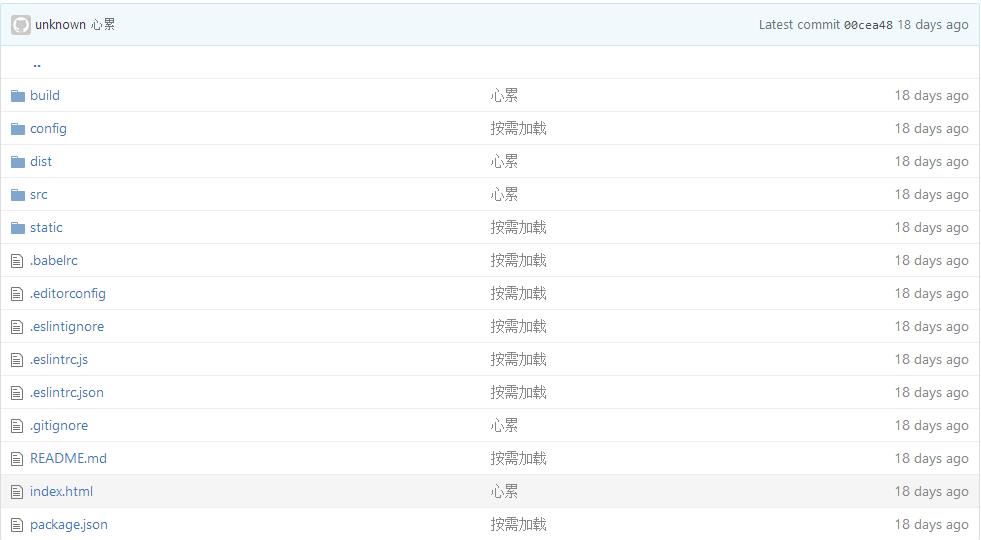Vuejs使用笔记 --- 框架
Posted 新科程序猿
tags:
篇首语:本文由小常识网(cha138.com)小编为大家整理,主要介绍了Vuejs使用笔记 --- 框架相关的知识,希望对你有一定的参考价值。
这两天学了vuejs的模板,于此纪录一下。

这是整个大文件夹的配置,现在我们看到的所有文件都不需要去管,说要关注也只需要关注“index.html”
"index.html"里面是这样的:
<!DOCTYPE html>
<html>
<head>
<meta charset="utf-8">
<title>Questionnaire</title>
<link href="http://cdn.bootcss.com/font-awesome/4.6.3/css/font-awesome.min.css" rel="stylesheet">
</head>
<body>
<app></app>
<!-- built files will be auto injected -->
</body>
</html>
里面的标签<app>就是我们整个页面的component,vuejs将页面的各个部分作为component搭建起来,整个页面就是一个大的component。
那么app在哪儿呢?在src文件夹下:有一个叫做App.vue的文件,就是存放名为app的vue实例的地方。
如果需要在一个文件中注册多个Vue对象,可以在js中如下定义(vuejs官网代码,局部注册):
var Child = Vue.extend({ /* ... */ }) // 定义一个名为Child的组件
var Parent = Vue.extend({
template: \'...\',
components: {
// <my-component> 只能用在父组件模板内
\'my-component\': Child // 这是一种内部的方式,表示Parent组件中包含Child,在Parent组件中直接使用<my-component></my-component>标签即可使用Child组件
}
})
回到App.vue,看一下里面的script代码:
import Header from \'./components/Header\'
import Index from \'./components/Index\'
import store from \'./vuex/store\'
export default {
components: {
\'v-header\': Header,
Index
},
store
}
1. import语句:声明其使用到的component或者vuex(全局数据容器,我是这样理解的,后面讲)
2. export语句: 导出其组成,components包括Header和Index,而数据容器为store。
App.vue的HTML代码如下:
<template>
<div id="app">
<v-header></v-header>
<router-view keep-alive></router-view>
</div>
</template>
router-view是一个顶级的路由外链,其会渲染一个和顶级路由匹配的组件,也就是router.map里面所声明的组件,我们先看看router.js:
router.map({
\'/index\': {
component: function(resolve) {
require([\'./components/Index\'], resolve)
}
},
\'/create\': {
component: function(resolve) {
require([\'./components/Create\'], resolve)
}
},
\'/edit/:questId\': {
component: function(resolve) {
require([\'./components/Edit\'], resolve)
}
},
\'/preview/:questId\': {
component: function(resolve) {
require([\'./components/Preview\'], resolve)
}
},
\'/data/:questId\': {
component: function(resolve) {
require([\'./components/Data\'], resolve)
}
}
})
比如说,我们在某个function中有一条语句:
this.$router.go(\'/components/Index\');
那么Index这个组件就会在App.vue中进行渲染,也就是该组件会在当前页面中显示。
可以看到最后两个router看起来有点特别:
\'/preview/:questId\':{...}
其实这是一种动态路径的渲染,比如在一个表单管理系统,有很多表单,每个表单都有一个id,那么打开不同的表单时,就会有不同的questID,这时就需要动态路径。那么对这种动态路径的捕获则采用:
this.$router.go(`/preview/${this.questionnaire.id}`) // 在src/create.vue中的vuex下的actions -> publish中,打开一个指定id的表单页面
在App.vue中,还有“store”这样一条语句,它表示的是vuex目录下的store.js:
store.js中存储的是整个表单系统的数据,也就是一个顶级的数据库,所有关于表单的更新都必须反馈到这个文件中,那么这是一种vuex的实例。
直接在js文件中写如下语句就可以生成一个vuex实例:
import Vuex from \'vuex\' import Vue from \'vue\' Vue.use(Vuex)
在那里面会有:初始表单数据,以及对表单数据进行更新的方法,比如:
const KEY = \'questionaireList\'
let questionaire01 = {name : value}
let questionaire02 = {name : value}
let quesitonaire03 = {name : value}
const mutations = {Method1, Method2 ...}
const state = {
questionaireList: JSON.parse(localStorage.getItem(KEY)), //所有的调查问卷,用KEY来检索
currentQuestionaire: null // 当前正在操作的调查问卷
}
function updateStorage(state){
// 每当questionaire(state)有更新时,就更新本地存储localStorage
localStorage.setItem(KEY, JSON.stringfy(state.questionaireList))
}
export default new Vuex.Store({
state,
mutations
})
在这里,存放了三个原始表单,定义了状态更改mutations里面的方法,定义了分发mutations的函数updateStorage
现在,我们可以通过store.state来读取state对象,或者通过dispatch某mutation名字来出发状态state更改:
store.dispatch(\'Method1\');
在外部的vue组件中,通常使用如下语法来访问store:
vuex: {
getters: {
questionnaireList: state => state.questionnaireList // 读取表单数据
},
actions: {
setQuest({dispatch}, item) {
dispatch(\'SET_QUEST\', item)
},
removeQuest({dispatch}, item) {
dispatch(\'RM_QUEST\', item)
}
}
}
在这种层层嵌套的风格中,如何使得子组件访问父组件的属性呢?这里需要用到props函数:
Vue.component(\'example\', { // 注册了一个组件
props: [\'showCalendar\']
})
当其他的组件使用到这个example组件时,就会得到example组件的\'showCalendar\'属性。
现在,我们已经知道了vue的框架是长什么样的,所以在使用vue的时候,我们有几件事情是需要关注的:
1. 确定数据类型,如表单中必然包含标题、问题等
2. 确定页面所需要的组件,比如需要一个通用的日历组件和标题组件。
3. 确定整个工程的页面,如创建、编辑、删除等,都在不同的页面操作,这些以页面为单位的components都应该在router中进行注册,并且编写相关的方法来决定跳转的时机。
4. 在每个component中设定相应的css样式等
5. 如果需要和服务器进行数据交互还需要vue-resource,使用起来也很方便:
{ // 可参考: https://github.com/vuejs/vue-resource/blob/master/docs/http.md
// GET /someUrl
this.$http.get(\'/someUrl\').then((response) => {
// success callback
}, (response) => {
// error callback
});
}
下面我们来看一下每一个component内部是怎么实现的 >> component内部实现
以上是关于Vuejs使用笔记 --- 框架的主要内容,如果未能解决你的问题,请参考以下文章